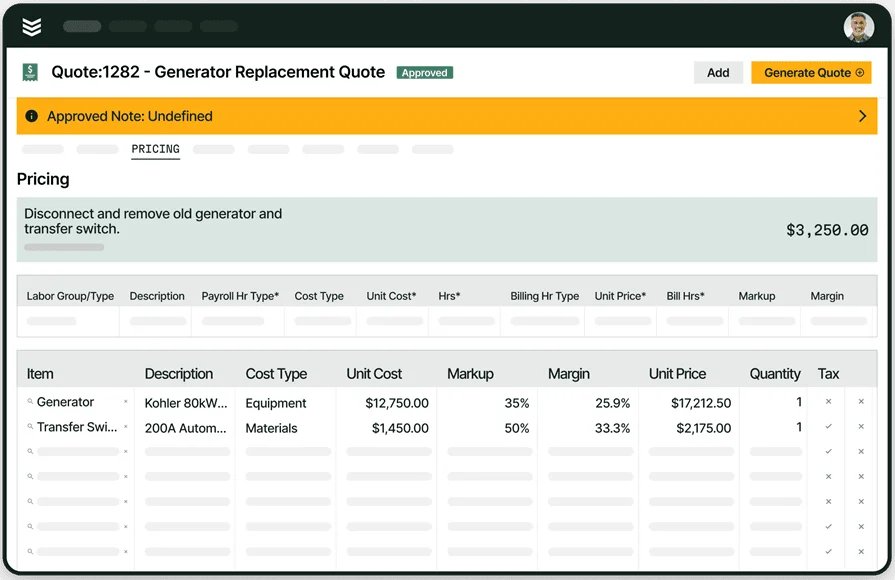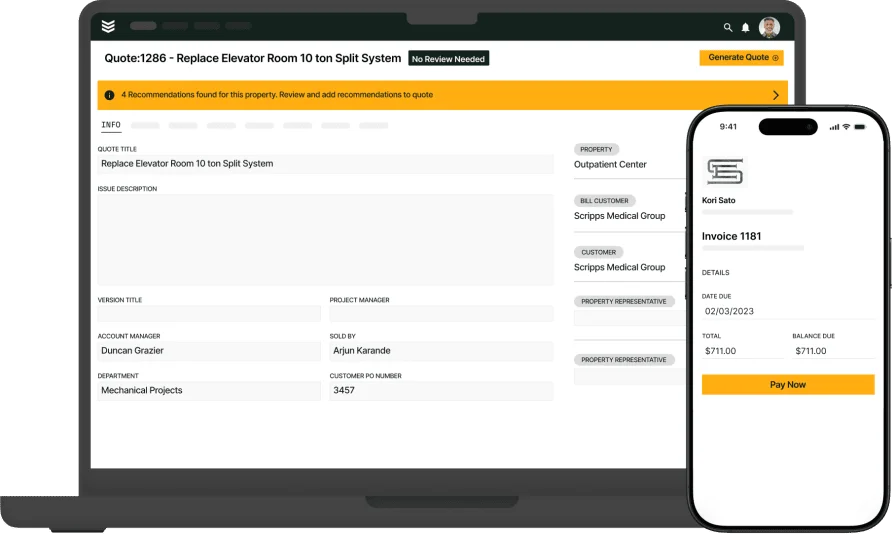Important
While BuildOps does not currently offer an electrical estimating book, we’re always looking into new and exciting tools and technology that are moving the industry forward, which is why we’re discussing the subject here.
For electrical contractors, quoting jobs can turn into a guessing game. One wrong number and your profit margin starts leaking fast. That’s where having an electrical estimating book becomes a game-changer. Instead of juggling spreadsheets, old quotes, or memory, you’ve got a reliable system that delivers fast, accurate estimates.
This guide breaks down how electrical contractors use estimating books to price jobs, win bids, and protect their bottom line — whether they're handling service calls, tenant build-outs, or full system installs. And in a trade like the electrical industry, where every job can come with its own surprises, having an estimating system you trust can make all the difference.
Here’s what we’ll cover:
- What is an electrical estimating book?
- 6 common electrical estimating methods
- Challenges of using basic electrical estimating templates
- 5 benefits of using an integrated electrical estimating book
- 8 tips for how to drive efficiency and profits with estimating software
Before you start dialing in your estimating system, it helps to understand exactly what an electrical estimating book is—and what makes it valuable on the job.
What is an electrical estimating book?
An electrical estimating book is a detailed reference packed with labor units, material costs, and task breakdowns, designed to help contractors and techs build fast, consistent job estimates. It provides cost breakdowns for each work phase, from conduit to panel upgrades, enabling accurate bids.
Rather than calculating every wire length, fixture count, or breaker size manually, techs and estimators pull directly from the electrical estimating book to assemble job costs for installations, repairs, or system upgrades. This keeps estimates reliable, competitive, and quick — especially when juggling multiple bids or tight deadlines.
6 common electrical estimating methods
When it comes to estimating electrical work, contractors have several ways to calculate job costs. Each method brings its own pros and risks, and the one you choose shapes how you bid, price, and protect profit.
- Unit pricing: Breaks the job into specific tasks with assigned labor units and material costs. Each fixture, outlet, or panel has a pre-set cost, making it easy to multiply quantities and calculate totals fast.
- Assembly estimating: Groups multiple parts of a task into one estimate line. For example, a lighting circuit includes wire, boxes, fittings, and labor combined into a single cost, reducing time spent itemizing.
- Square foot estimating: Uses cost per square foot based on building type and project scope. It's fast for budgeting large commercial jobs but requires experience to stay accurate.
- Contractor historical data: Relies on records from past jobs to guide pricing. Helpful when working on similar projects repeatedly but risky if the data isn’t regularly updated.
- Time and material estimating: Calculates actual labor hours plus real-time material costs. Transparent for customers but can create unpredictability if jobs take longer.
- Pre-built estimating software databases: Uses digital estimating systems loaded with current labor units, material prices, and assemblies. Keeps estimates accurate and consistent across projects.
Shifting from these methods to how they break down in the field is important — especially when old spreadsheets or manual processes still run the show. Next up: where estimating templates fall short.

Estimate better, Quote faster
Streamline estimating to get more quotes approved.
Challenges of using basic electrical estimating templates
At first glance, electrical estimating templates feel like a quick fix to bring order to job quoting. In reality, they often create new headaches. Whether it’s a spreadsheet, a PDF, or a printed chart, these templates still force techs to spend time digging for numbers. They’re flipping through tabs to build out panel replacements, punching in labor for gear installations, or scrambling to adjust material costs when prices shift.
Even digital templates don’t fully solve the problem. Having your estimating book on a laptop doesn’t mean the process flows faster. If your crew still needs to scroll for task codes, manually enter labor units for transformer installs, or build every quote from scratch, you're not saving time. You’re just swapping out paper for screens.
The real issue hits your crew’s pace. If techs are pausing mid-job to reference disconnected templates while bending conduit or wiring distribution panels, that’s valuable time lost. This slows down job sites, increases the chance of missing details, and makes onboarding new electricians harder when they’re still learning your systems.
When estimating ties directly into your quoting and billing software, the back-and-forth disappears. No second-guessing labor rates. No hunting for material markups. Estimates populate instantly, invoices connect directly to approved bids, and your team stays focused where they should — knocking out jobs.
Expert Tip
Tools like an electrical contractor invoice template and a field service report template keep everything connected from the estimate through the final report. In a trade where fast approvals and clean paperwork keep the schedule moving, that kind of system keeps your shop competitive.
5 benefits of using an integrated electrical estimating book
Trying to estimate off paper charts or static spreadsheets may work for a while, but it leaves plenty of room for costly mistakes, wasted hours, and headaches between the field and office. An integrated electrical estimating book built into your software can completely change how your shop handles job quoting and project management. Here’s how:
1. Consistent pricing every time
Your techs shouldn’t be pulling numbers from memory or wondering if yesterday’s quote lines up with today’s job. When your estimating book lives inside your system, labor units, material costs, and markups stay consistent across every estimate. That keeps your pricing tight whether you're bidding small tenant fit-outs or full commercial installs. It’s also why many contractors turn to electrical contractor project management software to keep estimates, schedules, and job costs aligned.
2. Cleaner quotes and fewer billing errors
When estimates are disconnected from your invoicing, details slip through—missing labor, incorrect materials, or mispriced change orders. Integrated estimating systems eliminate double entry and cut down on errors. And when paired with tools like an electrical contractor invoicing guide or an electrical work order invoice, your office can generate clean, accurate bills directly off approved estimates.
3. Faster onboarding for new estimators
When your electrical estimating book is built into your software, new hires aren’t stuck flipping through manuals or hunting down part codes. They search for the task, pull the built-in assembly, and generate accurate quotes fast. This shrinks training time, builds confidence, and helps protect margins even when your crew is learning the ropes.
4. Smarter upselling during job walks
Having estimating data at your tech’s fingertips makes it easier to catch upgrade opportunities in real time. If your team spots a chance to add surge protection or lighting control upgrades, they can generate accurate add-on pricing right there with the customer. Systems that combine estimating with sales features — like inventory data from electrical inventory management — help your techs close upsells without having to guess at costs or wait for office approvals.
5. Builds trust with your customers
When customers see clear, consistent estimates that match what lands on their final invoice, trust grows. Everything is transparent up front — labor, materials, equipment, and markups. And when your CRM ties directly into estimating, your team gets full visibility into job history, preferences, and opportunities to build repeat business. Platforms that include tools like the best CRM for electrical contractors make it easier to manage relationships and turn one-time customers into long-term accounts.

Check out the electrical toolkit
Access to top strategies, real-life examples, and downloadable templates.
8 tips for how to drive efficiency and profits with estimating software
Accurate estimates keep jobs profitable, reduce change orders, and give customers confidence in your pricing. When your electrical estimating book works directly inside your software, every part of the estimating process becomes faster, more consistent, and much easier to manage. Here’s how electrical contractors can sharpen their estimating process:
1. Use live pricing to keep material costs accurate
Material prices for wire, conduit, panels, breakers, and fittings change constantly. If your estimating book relies on outdated pricing, you risk underbidding and eating costs later. Pulling live supplier pricing directly into your estimates ensures every bid reflects real-time material costs. Integrated electrical construction estimating software gives estimators access to current prices as they build quotes, eliminating the guesswork and helping lock in accurate numbers before the job even starts.
2. Build service packages that simplify estimating for repeat jobs
Many estimating books break projects into standard tasks, but without smart templates, estimators still waste time rebuilding bids line by line. Bundling common services—such as “main panel swap,” “warehouse lighting upgrade,” or “service feeder replacement”—into pre-built estimating assemblies allows quick adjustments on labor units, material quantities, and pricing. This not only speeds up quoting but keeps estimating consistent across your entire team.
3. Turn approved estimates directly into accurate invoices
One of the biggest estimating breakdowns happens after the estimate is approved. Missed line items, forgotten change orders, or copy-paste errors turn into billing problems. When estimating and invoicing share the same system, approved estimates convert directly into invoices without re-entering data. Tools designed with electrical contractor billing software ensure that what was estimated is exactly what gets billed, protecting both your revenue and your customer’s trust.
4. Sync estimating with real inventory availability
An estimating book may list every part, but that doesn’t mean those parts are in stock. Estimators quoting jobs without knowing inventory levels risk committing to materials that aren't available, leading to delays and expensive change orders. When your estimating software syncs directly with your inventory system, you’ll see real-time part availability as you quote, avoiding double orders, restocking fees, and wasted time. This connection keeps estimates grounded in what your shop can deliver right away.
5. Let techs quote directly from the field
Quoting jobs hours after a site visit leaves too much room for missed details. With mobile access to your electrical estimating book, techs can build estimates right on-site while reviewing the job with the customer. This allows immediate pricing discussions, faster customer approvals, and far fewer back-and-forth calls to the office. Faster field quoting turns into faster booked jobs and stronger close rates.
6. Track estimate performance to fine-tune your bidding process
Most shops don't track what happens after an estimate is sent. Monitoring how long quotes sit, how many convert, and where margins land allows contractors to spot bidding problems early. Estimating software that ties into electrical dispatch software gives visibility into which bids turn into scheduled work — and where certain job types or services may need pricing adjustments.
7. Apply pricing rules that automatically protect margins
Even experienced estimators make mistakes under pressure. Rule-based estimating ensures that minimum labor rates, overhead percentages, and material markups are always applied properly. Software with built-in pricing rules reduces underbidding risk, even when new team members handle estimates. This keeps profitability consistent across every quote without relying on gut feel.
8. Connect estimating with full customer and job history
Strong estimating doesn’t start from scratch every time. When estimates link directly to job history and customer profiles, techs and estimators can see past repairs, upgrades, and patterns before quoting. This visibility allows for proactive recommendations, service upsells, and stronger customer conversations. CRM platforms designed for contractors, like the best CRM for electrical contractors, keep full customer data tied to every estimate, helping you turn one-time jobs into long-term accounts.
An electrical estimating book gives contractors a reliable foundation for pricing jobs, controlling costs, and keeping bids competitive. But even the best book has limits when it's disconnected from the rest of your operation. Managing labor rates, material costs, and complex assemblies becomes harder when you're flipping between spreadsheets, templates, and scattered files.
That’s where integrated software changes the game. A full system doesn't just store prices — it connects estimating to your scheduling, dispatch, invoicing, inventory, CRM, and every part of your field service workflow. For commercial contractors balancing multiple crews, tight timelines, and fast-changing job scopes, having one platform to manage the entire process is the difference between constant back-and-forth and a smooth-running operation. Platforms like BuildOps bring all of this together, built specifically for the demands of commercial electrical work.

See how it works in action
Run jobs faster, from the very first estimate to project closeout.






